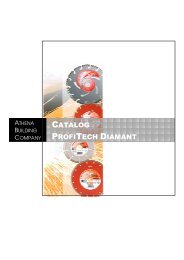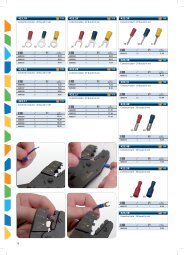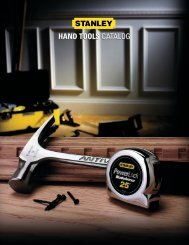Main catalogue - Athena Building
Main catalogue - Athena Building
Main catalogue - Athena Building
Create successful ePaper yourself
Turn your PDF publications into a flip-book with our unique Google optimized e-Paper software.
Wet & dry vacuum cleaners<br />
Vacuum cleaners<br />
Power, air suction, depressure:<br />
which technical data is most<br />
important?<br />
The right technical data of a<br />
vacuum cleaner is the vacuum<br />
efficiency, that is the mix of<br />
different values, i.e. air suction,<br />
motor power and depression. Air<br />
suction is the vacuumed air volume,<br />
commonly expressed in litres per seconds<br />
(l/sec) and it is the result of the average<br />
air speed multiplied by hose diameter. The<br />
depression is the vacuum power (it can be<br />
defined as the vacuum power to collect dirt) and<br />
it is commonly expressed in kPA or in mbar. It is an<br />
inverse relation to air suction: the narrower the flex<br />
diameter, the least<br />
vacuumed air volume but the best strength to pick up dirt.<br />
Power motor is expressed in Watt and it is<br />
not proportional to vacuumefficiency!<br />
If the vacuum cleaner is not well-done, it wastes a lot<br />
of electric power without having the best performances<br />
possible. Summing up, the vacuum cleaner efficiency<br />
is a relationship between air suction (resulting in<br />
multiplication of pressure and air suction) and motor<br />
power. All our vacuum cleaners have a top efficiency and<br />
are manufactured considering essence and user’s benefit.<br />
Fixed or tilting trolley, which one to choose?<br />
The choice of the trolley must be made considering the<br />
type of use needed. Generally, tilting trolley is much more<br />
useful to collect dust and solids, because the tilting tank<br />
make it easier the emptying or pouring. The fixed trolley<br />
is better for liquids vacuuming, because it is equipped<br />
with drain hose system, emptying is fast and step by step,<br />
avoiding the effort of lifting the tank.<br />
What kind of tank material is to be<br />
preferred?<br />
Our vacuum cleaner range includes plastic tanks<br />
(polypropylene or PP) or stainless steel tanks. The PP tank<br />
is flexible, shock proof and resistant to chemical<br />
products. It is recommended for frequent moving uses<br />
or vacuuming of particularly aggressive chemicals (for<br />
example in combination with a single disc machine). The<br />
stainless steel tank is more rigid, steadier, resistant to<br />
mechanical abrasion and it is aesthetically agreeable. It<br />
is recommended for static use, with abrasive materials or<br />
in a public place.<br />
What safety vacuum cleaners are?<br />
Safety vacuuming means that the product is entirely<br />
certificated (not the filter only, but the entire machine) in<br />
order to comply with the strictest directives and European<br />
rules that regulate vacuuming of dust dangerous for<br />
health, divided into two groups: hazardous dust and<br />
explosives ones. Hazardous dust are also divided in:<br />
dust with OEL* value and cancerogenous dust (asbestos<br />
is considered a cancerogenous dust only in Germany<br />
and it needs another classification and certification).<br />
An example of this dust is asbestos, food or wood<br />
preservatives and fertilizers.<br />
Explosive dust is for example wood dust, aluminium dust<br />
and flour.<br />
68







